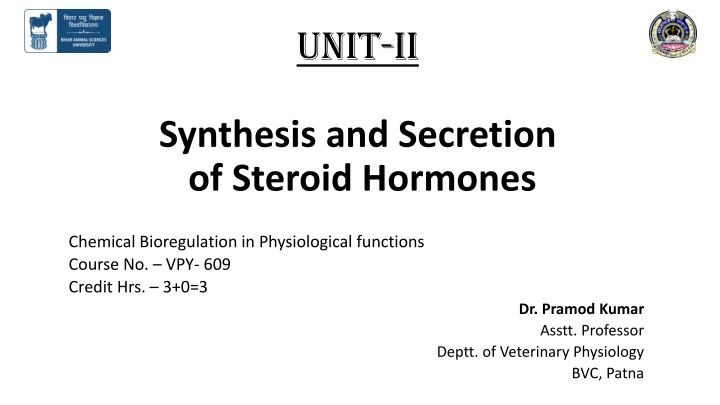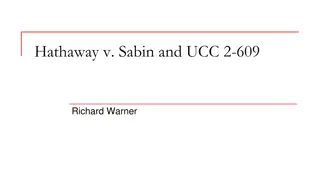
Steroid Hormone Synthesis and Secretion in Mammals
Explore the intricate process of steroid hormone synthesis from cholesterol in mammalian systems. Learn about the diverse functions of steroid hormones and their importance in maintaining physiological balance. Discover the roles of various organs in steroid biosynthesis and the enzymatic pathways involved in hormone production.
Download Presentation

Please find below an Image/Link to download the presentation.
The content on the website is provided AS IS for your information and personal use only. It may not be sold, licensed, or shared on other websites without obtaining consent from the author. If you encounter any issues during the download, it is possible that the publisher has removed the file from their server.
You are allowed to download the files provided on this website for personal or commercial use, subject to the condition that they are used lawfully. All files are the property of their respective owners.
The content on the website is provided AS IS for your information and personal use only. It may not be sold, licensed, or shared on other websites without obtaining consent from the author.
E N D
Presentation Transcript
Unit-II Synthesis and Secretion of Steroid Hormones Chemical Bioregulation in Physiological functions Course No. VPY- 609 Credit Hrs. 3+0=3 Dr. Pramod Kumar Asstt. Professor Deptt. of Veterinary Physiology BVC, Patna
Introduction Introduction In mammalian systems, there are six families of steroid hormones that can be classified on chemical and biological basis. They are the estrogens, progesterone, androgens, mineralocorticoids, glucocorticoids and vitamin D. These steroid hormones play a critical role in numerous physiological and pathophysiological processes. The vast majority of circulating steroids in mammals come from the endocrine activity of the gonads and adrenal glands, which metabolize the lipid cholesterol to generate the steroid repertoire.
Steroids have a complicated structure of fused rings having a wide array of modifications of hydroxyl or carbonyl substituents and unsaturation (double or triple bonds). Steroids are derived from a phenanthrene ring structure to which a pentane ring has been attached, this yields in the completely hydrogenated form, cyclopentanoperhydrophenanthrene or the sterane ring structure. The six-carbon atoms of a cyclohexane ring are not fixed rigidly in space, but are capable of interchanging through turning and twisting between several structural arrangements in space.
Steroid Biosynthesis The natural steroid hormones are generally synthesized from cholesterol in the gonads and adrenal glands. These forms of hormones are lipids. They can pass through the cell membrane as they are fat-soluble and then bind to steroid hormone receptors to bring about changes within the cell. Steroid hormones are generally carried in the blood, bound to specific carrier proteins such globulin or corticosteroid-binding globulin. Further conversions and catabolism occurs in the liver, other peripheral tissues and in the target tissues. as sex hormone-binding
oSteroidogenic enzymes are responsible for the biosynthesis from cholesterol of various steroid hormones including glucocorticoids, mineralocorticoids, progestins, androgens and estrogens. They consist of several specific cytochrome P450 enzymes (CYPs), hydroxysteroid dehydrogenases (HSDs) and steroid reductases (Miller, 1988). oNumerous organs are known to have the capacity to synthesize biologically active steroids, including the adrenal gland, testis, ovary, brain, placenta and adipose tissue. oDe novo synthesis of all steroid hormones starts with the conversion of cholesterol to pregnenolone by CYP11A (cholesterol side-chain cleavage). CYP11A is bound to the inner membrane of the mitochondrion and is found in all steroidogenic tissues but is not or poorly expressed in non-steroidogenic tissues.
oPregnenolone is converted to progesterone by 3-hydroxysteroid dehydrogenase (3 -HSD), one of several non-CYP450 enzymes involved in steroidogenesis and which is found in both mitochondria and smooth endoplasmic reticulum. 3 -HSD is widely distributed in steroidogenic and non-steroidogenic tissues and consists of two isoenzymes, which are regulated in a tissue-specific manner. oThe type 2 3 -HSD is predominantly expressed in steroidogenic tissues such as adrenal, testis and ovary. oWhereas type 1 is found in placenta and in non-steroidogenic tissues such as liver, kidney and skin. Pregnenolone and progesterone form the precursors for all other steroid hormones.
Transport oThese are transported through the blood through serum proteins that bind them and increase the hormones solubility in water. oSome examples are sex hormone binding globulin, corticosteroid binding globulin and albumin. When it gets active, steroid hormones free themselves from their blood-solubilizing proteins and either bind to extracellular receptors or passively cross the cell membrane and bind to nuclear receptors. This idea is known as the free hormone hypothesis. oThe steroid hormones are endocytosed and proceed to affect cells via a genomic pathway.
oThe steroid-carrier complexes are bound by megalin, a membrane receptor and are then taken into cells via endocytosis. Once it enters inside the cell these complexes are taken to the lysosome, where the carrier protein is degraded and the steroid hormone is released into the cytoplasm of the target cell. The hormone then follows a genomic pathway of action. The role of endocytosis in steroid hormone transport is not well understood and is under investigation. oIn order for steroid hormones to cross the lipid bilayer of cells, they must overcome energetic barriers that would prevent their entering or exiting the membrane. These hormones, which are all derived from cholesterol, have hydrophilic functional groups at either end and hydrophobic carbon backbones.
oWhen steroid hormones are entering membranes free energy barriers exist when the functional groups are entering the hydrophobic interior of membrane, but it is energetically favorable for the hydrophobic core of these hormones to enter lipid bilayers. These energy barriers and wells are reversed for hormones exiting membranes. Steroid hormones easily enter and exit the membrane at physiologic conditions. oThough it is energetically more favorable for hormones to be in the membrane than in the ECF or ICF, they do in fact leave the membrane once they have entered it. This is an important consideration because cholesterol the precursor to all steroid hormones does not leave the membrane once it has embedded itself inside. This is because the aliphatic tail on cholesterol has a very favorable interaction with the interior of lipid bilayers
Mechanisms of action and effects Genomic pathways - The first identified mechanisms of steroid hormone action were the genomic effects. In this pathway, the free hormones first pass through the cell membrane because they are fat soluble. In the cytoplasm, the steroid may or may not undergo an enzyme-mediated alteration such as reduction, hydroxylation or aromatization. Then the steroid binds to a specific steroid hormone receptor also known as a nuclear receptor, which is a large metalloprotein. Upon steroid binding, many kinds of steroid receptors dimerize: two receptor subunits join together to form one functional DNA-binding unit that can enter the cell nucleus. Once in the nucleus, the steroid-receptor specific DNA sequences and induces transcription of its target genes. ligand complex binds to
Non-genomic Because non-genomic pathways include any mechanism that is not a genomic effect, there are various non-genomic pathways. However, all of these pathways are mediated by some type of steroid receptor found at the plasma membrane. transporters, G-protein coupled receptors and fluidity have all been shown to be affected hormones. Of linked proteins are the most common. pathways - hormone Ion channels, membrane by these, steroid GPCR Estradiol

